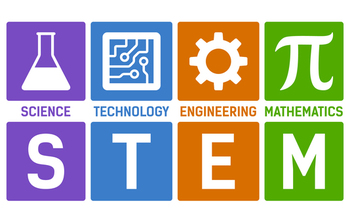The concept of STEM Programs in Schools has been making headlines lately. It is a path-breaking educational program that aims to bring 360° development in the students. So, if you are new to this concept and want to know everything about STEM, you have reached the right place.
Here we explain all the essentials of STEM Programs in Schools, their advantages, and their scope. Then, let’s dive into the details.
Introduction to STEM
STEM education combines science, technology, engineering, and maths into a single, integrated, practical learning experience instead of concentrating on each discipline separately. Experts believe that STEM-related occupations will be necessary for the future to keep up with the rapid advancement of technology.
Students must therefore pay more attention to these subject areas to better position themselves for success in the future. In addition, they can seek guidance from their teachers to understand how to study Chemistry to be outstanding.
Although early childhood education has many advantages, STEM Programs in Schools are designed to provide hands-on experience to the students. Therefore, the STEM curriculum heavily focuses on developing key skills like:
- Creativity
- Problem-solving
- Teamwork
- Critical analysis
- Initiative
- Digital literacy
- Communication
- Critical thinking
Importance of STEM Programs in Schools
Why should parents consider enrolling their children in STEM programs in Canada? Here are the top reasons why you should consider the STEM curriculum over the traditional study curriculum.
Develop a Strong Knowledge Base
For many students, Mathematics, Science, and Physics are challenging subjects. Early STEM exposure helps such kids prepare for more tough courses in higher education. The strong concept foundation will always be an added advantage in their lives.
Students needing assistance clearing their scientific concepts should meet their teachers to learn the top pro tips for science learning. It will help them prepare for the examinations better.
Promotes Imagination
STEM Programs in Schools aim to promote the imagination of the students. These courses encourage finding multiple solutions to an issue. In contrast to conventional textbook
instruction, STEM education encourages students to use their imaginations to develop innovative solutions to problems. Coding a LEGO is one of the popular STEM education examples used for promoting vision in students.
STEM is the Future of the World
Experts believe the global economy relies more strongly on STEM education more than ever. Whether in healthcare, construction, or the environment, STEM can regulate every sector effectively.
Moreover, as per the latest reports of the BLS, STEM career options are expected to grow 8.8% by 2028. That’s not all. The forecasts state that the United States will require 1 million more STEM specialists in the near future. All these stats prove that STEM will be the world’s next future.
STEM Teaches Innovation and Critical Thinking
Besides providing promising job opportunities in the future, the STEM curriculum focuses on the core development of the students. It teaches them two crucial new-age skills – critical thinking and innovation.
Students can develop mental habits that will help them succeed in any area of life. Can online
math tutoring help in this process? Yes. It can immensely help in enhancing the critical reasoning skills of the students. Thanks to the emphasis on logical thought processes and
problem-solving.
The curriculum motivates students to think critically and develop original answers. Therefore, students who obtain a top-notch STEM education in Canada are better prepared to lead the next generation of innovators. Online math tutoring can also help enhance these skills in students.
STEM Promotes Teamwork
One of the most undervalued but crucial success factors is teamwork. In the contemporary world, collaborating in some capacity—often with a sizable and diverse group of people—is necessary for successful projects.
STEM education in Canada offers better insight into teamwork than other coursework. So, whether students need to collaborate on an engineering challenge or a lab inquiry, they effectively learn the team skills they will need. Teachers can teach this skill with several STEM activities. Building a hand crank is one of the top STEM education examples for such projects.
Helps Develop Project Management Skills
STEM classes, particularly those in technology and engineering, usually include hands-on practical assignments. For example, a simple robot, engine, or computer program often includes multiple steps completed over several days.
Moreover, it helps students learn the nuances of project management and time management skills. The STEM Programs in Schools also teach how to divide larger tasks into manageable steps. These skills will help students throughout their lives, whether working on a remodeling or office project.
Develop Technical Know-How
Students can learn computational reasoning, coding, innovation, and scientific and engineering design through STEM Programs in Schools. These competencies are a vital part of the science and technology industries. Moreover, these skills are in high demand in today’s interconnected world, where advances in science and technology continue to
affect every aspect of our lives.
Students create, construct, and test devices, models, structures, and systems using the engineering design process and related skills. They also compose and run code for investigations and when conceptual modeling. Creating a stop-motion animation video is one of the popular STEM education examples to use here.
Exposure to Real-World Challenges
STEM education in Canada shares a glimpse of the real-world challenges to the students. Do you know how? Combining elements from two or more STEM-related subjects in a single classroom activity. It prepares students for real-life problems. They learn the technicalities of complex problem-solving and understand the practical applications of concepts.
These activities may include contexts from the student’s home, community, or occupations, including the skilled trades. In addition, incorporating several STEM-related topics helps improve students’ comprehension of each subject and how it relates to others.
Bottom Line
The strands of STEM education in Canada is woven throughout the science and technology curriculum. It aims to create future innovators and leaders for ethical and sustainable societal and workforce change.
It also wants to develop integrative thinking and problem-solving opportunities in our diverse communities. In addition, the curriculum encourages students’ scientific and technological literacy, allowing them to better appreciate, comprehend, and navigate the world in which they live.


